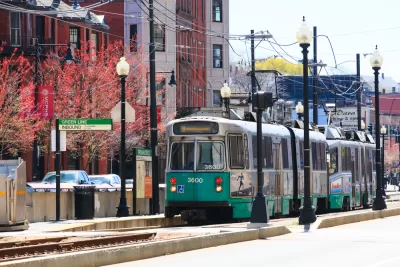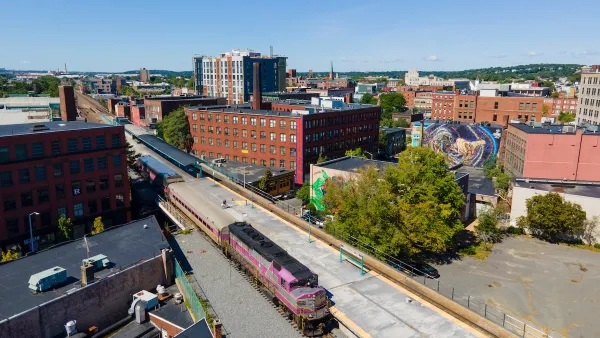The MBTA Communities law sets ‘minimum multi-family unit capacity’ for communities located near transit stations to boost higher-density housing development in transit-rich areas.

Writing in Commonwealth Magazine, Amy Dain explains Massachusetts’ new MBTA Communities law, which requires “cities and towns served by the MBTA (outside of Boston) to zone a district “of reasonable size” for multi-family housing near MBTA stations, where practical.”
Dain describes the measure used by the state to calculate ‘reasonable size,’ what the state calls “minimum multi-family unit capacity” or zoning capacity. “If you draw a zoning district for multi-family housing (defined as buildings with three or more dwelling units) on a municipal zoning map, you can add up how many housing units in multi-family buildings could theoretically and maximally be built on every existing parcel in the district, based on what the zoning allows, regardless of what exists on each parcel or what the market might favor for each parcel. This count yields the zoning capacity of the district for multi-family housing,” Dain writes.
Notably, “Zoning capacity is not a home production goal,” but “a legal envelope of allowed buildings; an estimated count of technically allowed dwelling units.” Requirements for each community will vary based on the type of transit present, existing density, and other factors. “A district that is reasonable in one city or town may not be reasonable in another city or town, the guidelines explain.”
FULL STORY: What the MBTA Communities law means for your town

Planetizen Federal Action Tracker
A weekly monitor of how Trump’s orders and actions are impacting planners and planning in America.

Map: Where Senate Republicans Want to Sell Your Public Lands
For public land advocates, the Senate Republicans’ proposal to sell millions of acres of public land in the West is “the biggest fight of their careers.”

Restaurant Patios Were a Pandemic Win — Why Were They so Hard to Keep?
Social distancing requirements and changes in travel patterns prompted cities to pilot new uses for street and sidewalk space. Then it got complicated.

Platform Pilsner: Vancouver Transit Agency Releases... a Beer?
TransLink will receive a portion of every sale of the four-pack.

Toronto Weighs Cheaper Transit, Parking Hikes for Major Events
Special event rates would take effect during large festivals, sports games and concerts to ‘discourage driving, manage congestion and free up space for transit.”

Berlin to Consider Car-Free Zone Larger Than Manhattan
The area bound by the 22-mile Ringbahn would still allow 12 uses of a private automobile per year per person, and several other exemptions.
Urban Design for Planners 1: Software Tools
This six-course series explores essential urban design concepts using open source software and equips planners with the tools they need to participate fully in the urban design process.
Planning for Universal Design
Learn the tools for implementing Universal Design in planning regulations.
Heyer Gruel & Associates PA
JM Goldson LLC
Custer County Colorado
City of Camden Redevelopment Agency
City of Astoria
Transportation Research & Education Center (TREC) at Portland State University
Camden Redevelopment Agency
City of Claremont
Municipality of Princeton (NJ)





























